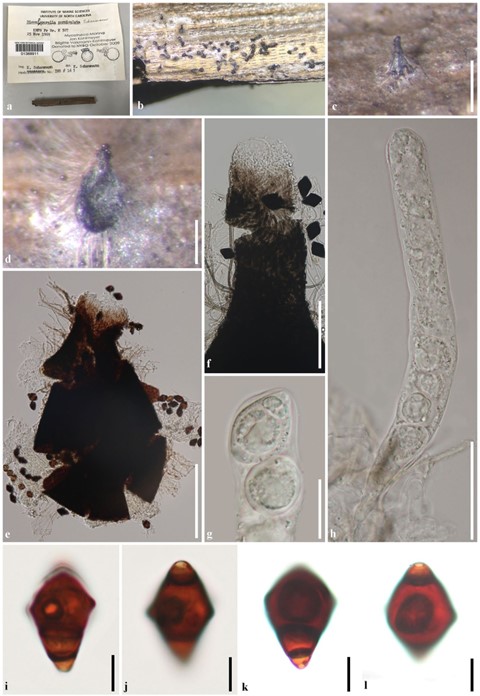Biconiosporella corniculata Schaumann, Veröff. Inst. Meeresf. Bremerhaven 14(1): 24 (1972)
MycoBank number: MB 309544; Index Fungorum number: IF 309544; Facesoffungi number: FoF 10037; Fig. 54
Saprobic on wood. Sexual morph: Ascomata 275–470 × 150–240 µm (x̄ = 370 × 180 µm, n = 5), perithecial, scattered, semi-immersed to superficial, globose to subglobose, collapsing when dry, membranaceous, black, ostiolate, with papilla. Peridium comprising dark brown to hyaline cells of textura angularis. Asci (200–)220–250(–300) × 20–35 µm (x̄ = 230 × 26 µm, n = 20), 8-spored, unitunicate, cylindrical, pedicellate, apex rounded, evanescent. Ascospores 28–35(–38) × 19–25 µm (x̄ = 33 × 22.5 µm, n = 50), uni-seriate, obovoid to ellipsoidal, hyaline when young, becoming pale brown to brown when mature, smooth-walled, with a germ pore at each end and 3–4 obvious coniform tubercules evenly distributed at middle, 3-septate, one septum near apex, two septa near the truncate base. Asexual morph: Undetermined.
Material examined: Germany, on rotten wood in sea water, 25 November 1969, K. Schaumann (NY-01388911, holotype).
Known hosts and distribution: On dead wood in Germany (type locality) (Schaumann 1972).
Notes: The monotypic Biconiosporella has unique ascospores with coniform tubercules at center. We re-examined the holotype which is well preserved, but there were no mature asci.

Fig. 54 Biconiosporella corniculata: (NY-01388911, holotype). a Herbarium mate- rial label. b Scattered ascomata. c Ascoma on host. d Col- lapsing ascoma. e Squashed ascoma. f Ostiole. g Apex of ascus. h Ascus (immature). i–l Ascospores. Scale bars: c = 500 µm, d. e = 200 µm, f = 100 µm, h = 50 µm, g = 20 µm, i–l = 10 µm
